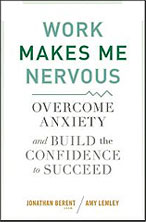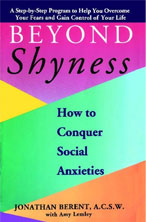When Fear of Public Speaking is an Anxiety Disorder
While patient E was approaching a 7 figure salary at age 42 as a financial portfolio manager, he avoided any scenario which required a monologue in front of a group. He had a very active relationship with alcohol as his primary means of “repressing” his social and performance anxiety.
Patient P was the head accountant at a large firm who popped a Xanax at the first sign of any visceral discomfort. This occurred in any scenario where he felt judged, especially in front of any size group. He was frequently up to 5-6 pills per day and often added the stimulant Provigal to bring him up from the sedative effect of the Xanax. Up and down, up and down everyday, at work, for 15 years. He was in denial that he was a “high functioning addict” as his rationale was that he didn’t take these specific pills when he was not at work; only his Celexa.
Patient M, a rising star in international banking at age 32, often missed conference calls and important weekly management meting due to his public speaking anxiety, the root cause of which was his historical challenge with stuttering. While he did not stutter in real time, he engineered an elaborate defensive strategy where he backed away from any words or syllables that could possibly activate a stutter. This occurred in his personal life also; when ordering at a restaurant, while socializing.
Patient J, age 33, was an environmental researcher. She avoided any scenario where her facial hyper-hidrosis (blushing) could be activated. The anxiety of speaking in public, to any size group, was a major trigger for her social anxiety driven blushing. Due to her phobic avoidance she was not able to evolve into a management position.
Patient R, age 40, was a human resources consultant, who never said a word in her weekly staff meeting, where 20 of her associates sat around a table discussing issues of the week. She would say in therapy “I never have anything to say”, or I don’t know what to say”. While this is obviously public speaking anxiety, the specific dynamic of self-censoring is more specifically an example of adult selective mutism. It was the self-censoring which drove the public speaking anxiety.
I’m sure that most of you who are reading this have heard the joke that many people would rather die than speak in public. I have countless stories which reinforce this. This includes individuals who consider changing careers, or who contemplate getting into a car accident (on the way to work) to avoid scenarios that activate their public speaking anxiety.
Speaking in Public Anxiety vs. Public Speaking Anxiety
While public speaking anxiety, which is a specific example of social anxiety, is the world’s number one phobia, a broader understanding of this phenomenon can be achieved with the realization that:
Texting is the Most Common Form of Communication
The proliferation of technology has added to productivity in many ways, and also in many ways has increased certain methods of interaction. On the other hand it has enabled an astounding degree of avoidance of actual human interaction and verbal communication. The neural pathways required for verbal communication have been inhibited and handicapped on a worldwide basis. This is no joke. In this sense, evolving technology is breeding social anxiety and communication anxiety. The algorithm in place appears to be that the situation and specific problem of verbal communication will only increase. In this sense, it appears that the most common anxiety worldwide appears to be conversation anxiety. Indeed, the most common thing that I have heard from patients of all ages since 1978 has been “I don’t know what to say”, or “I have nothing to say”.
Public Speaking Anxiety Disorder Profile
Check the following which apply to you:
There is a consistent pattern where I avoid scenarios which require me speaking in public.
When I do speak in public I am very uncomfortable.
I worry about being noticeably nervous when speaking in public.
I am dependent on substances (prescription or otherwise) in order to be able to speak in public.
When I avoid a public speaking scenario I rationalize by saying to myself that I “will do it next time”.
I often panic, or fear that I will panic, when speaking in public.
After speaking in public I tend to obsess on what I said.
I obsess about how people will judge me when I speak in public.
I tend to have two levels of fear when speaking in public:
1. People will see that I’m nervous.
2. People will see who I really am.
Ten Clinical Dynamics for Resolving Public Speaking Anxiety Disorder
The following are the primary dynamics that are needed to resolve both public speaking anxiety in a formal setting and public speaking anxiety in informal settings. In treatment technique is combined with “core” work. The domains of physiology, behavior, thinking, and emotion are integrated into therapy. Think of
F – Function = Physiology
A – Action = Behavior
T – Thinking = Cognition
E- Emotion
- Understanding the “physiology of performance”.
- Learning the adrenaline control methodology based on the paradoxical concept of adrenaline acceptance.
- Learning, analytically speaking, how the negative association to the adrenaline-driven visceral response was learned.
- Understanding the hyper-vigilance-avoidance syndrome.
- Resolving the emotions of embarrassment, humiliation, and shame.
- Resolving anger and rage, which may exist in non-conscious domains.
- Making a “bridge” between the intellectual and emotional minds.
- Understanding the “nurturing deficit” and developing self-nurturing strategies.
- Creating a behavioral methodology.
- Tools for reinforcing success.
Options for treatment for public speaking anxiety disorder:
- The Book “Work Makes Me Nervous: Overcome Anxiety and Develop the Confidence to Succeed” (Wiley).
- Self-help Audio CD for public speaking anxiety.
- Therapy in Great Neck, via telephone, or skype.
Self-Help and Treatment Options
- Free Audio CD from Social-Anxiety.com
- Social Anxiety: The Untold Story
- Beyond Shyness: How To Conquer Social Anxieties
- Work Makes Me Nervous
- Comprehensive Self-Therapy Audio Program
- Public Speaking Anxiety Self-Therapy Audio Program
- “Warm Hands Cool Face” A Self-Help Clinical Program for Blushing Anxiety & Erythrophobia
- The Berent Method: High Performance Therapy for Social-Anxiety
- Telephone/skype therapy available worldwide
- Selective Mutism Seminar Audio CD/MP3 Program
- Self-Help Program for Parents of Children with Selective Mutism
- The Sociability Questionnaire
- Tip of the Month Club
- Social Therapy and The Learning Disabled
- Free Parent Addiction Survey


